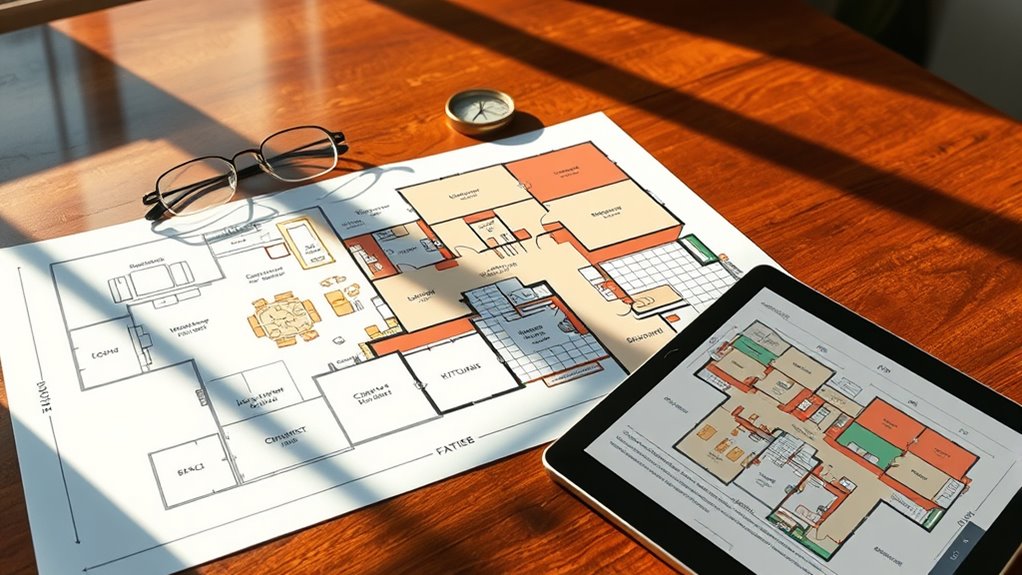To read a floor plan effectively, start by mastering basic symbols and icons representing doors, windows, and fixtures. Understand the scale to translate measurements accurately. Identify main entry points and distinguish room types based on function. Analyze wall thickness for structural insight and review furniture layouts for space use. Interpret electrical and plumbing symbols carefully. Assess traffic flow for practical movement and consider outdoor areas like patios and garages. Following these steps will prepare you to explore detailed plan nuances confidently.
Understand the Basic Symbols and Icons

In floor plans, symbols and icons serve as a universal language that conveys detailed information about the layout and features of a space. When you approach a floor plan, understanding symbol significance is essential to accurately interpret walls, doors, windows, and fixtures. Each icon represents specific elements—doors are typically shown as arcs, while windows appear as breaks in walls. By mastering icon interpretation, you gain the freedom to visualize the spatial organization without confusion. This knowledge empowers you to make informed decisions about functionality and design. Pay close attention to standardized symbols to avoid misreading important details. Your ability to decode these icons precisely forms the foundation for comprehending complex architectural drawings and enhances your autonomy in maneuvering or modifying a given space.
Identify the Scale and Measurements
Three key elements define how you interpret a floor plan’s scale and measurements: the scale ratio, unit of measurement, and dimension lines. First, identify the scale ratio—commonly expressed as 1:50 or 1/4”=1’—to understand how real dimensions translate on paper. Precision in scale accuracy guarantees you can confidently calculate actual room sizes. Next, observe the measurement units used, whether metric (meters, centimeters) or imperial (feet, inches), and stick to them consistently for clarity. Finally, dimension lines on the plan indicate exact lengths between walls or features; these lines are critical for verifying spatial relationships. By mastering these components, you gain the freedom to accurately visualize and manipulate space, making your interpretation both reliable and actionable.
Locate the Main Entry Points

Start by pinpointing the front door location on the floor plan, as it defines the primary access point. Then, identify any secondary entrances to understand alternative access routes. Finally, analyze how these entry points influence the overall flow and connectivity within the space.
Identify Front Door Location
One key step in reading a floor plan is pinpointing the front door location, which serves as the primary access point to the building. You’ll want to assess the door orientation to understand how it directs movement flow and affects entrance visibility. This helps you grasp how freedom of access is designed into the layout.
| Feature | Description | Impact on Flow |
|---|---|---|
| Door Orientation | Position relative to walls | Guides entry direction |
| Entrance Visibility | Sightlines from outside | Enhances security & ease |
| Access Point Type | Single/double door | Influences traffic flow |
Check Secondary Entrances
Although the front door is often the primary access, you should also identify secondary entrances to fully understand the building’s access points. These secondary access points are essential for safety and convenience, especially for emergency exits.
When examining the floor plan, focus on:
- Side or Rear Doors: Often used for staff or service entry, they provide alternative routes.
- Emergency Exits: Clearly marked, these doors guarantee quick evacuation during emergencies.
- Garage or Loading Bays: These may serve as additional access points for vehicles or deliveries.
Understand Access Flow
When you examine a floor plan, understanding the access flow by locating the main entry points is essential for grasping how movement within the building is organized. Identify the primary access points first; these serve as the main gateways directing traffic and influencing movement patterns throughout the space. Note their position relative to secondary entrances and internal pathways to understand circulation efficiency. Recognizing where occupants enter and exit allows you to anticipate natural flow directions and potential congestion areas. This clarity helps you evaluate how freely occupants can navigate, ensuring the layout supports ease of movement and accessibility. By precisely mapping access points and analyzing the resulting movement patterns, you gain insight into the building’s functional dynamics and how its design facilitates or restricts freedom of movement.
Recognize Different Room Types

You’ll need to identify common room symbols to accurately interpret each space on the floor plan. Pay attention to how functional areas are organized and labeled to understand their intended use. Also, distinguish between private and public rooms to grasp the flow and accessibility within the layout.
Common Room Symbols
Floor plans use standardized symbols to represent different room types, allowing you to quickly identify the function of each space. Understanding these common symbols and room indicators frees you from confusion and lets you navigate designs with confidence. Here are three essential symbols you’ll encounter:
- Kitchen: Depicted by a sink and stove icon, often accompanied by cabinetry outlines.
- Bathroom: Marked with fixtures like a toilet, bathtub, or shower stall symbol.
- Bedroom: Usually shown with a bed symbol or simply labeled, indicating private sleeping areas.
Identifying Functional Areas
Recognizing common room symbols sets the foundation for identifying functional areas within a floor plan. You’ll quickly distinguish living zones—spaces designed for relaxation and socializing—from activity areas, which support specific tasks like cooking or working. Each room type has unique characteristics that guide your interpretation.
| Room Type | Common Function |
|---|---|
| Living Room | Socializing, relaxation |
| Kitchen | Food preparation |
| Bedroom | Rest, privacy |
Differentiating Private vs. Public
Although room functions vary widely, distinguishing between private and public spaces is essential for understanding a floor plan’s layout. This zone differentiation reflects the design intentions behind functional segregation, balancing privacy levels and social interaction. When analyzing a floor plan, focus on:
- Access Control: Public areas like living rooms and kitchens often have open access, while private spaces such as bedrooms and bathrooms feature restricted entry to guarantee privacy.
- Privacy Levels: Notice how private spaces are typically positioned away from high-traffic zones, providing seclusion.
- Social Interaction: Public areas encourage gathering and interaction, whereas private spaces support solitude and personal use.
Understanding these distinctions empowers you to interpret the spatial hierarchy accurately, respecting the intended freedom of movement and use within the environment.
Analyze Wall Thickness and Structure
Since wall thickness directly impacts a building’s stability and insulation, you need to carefully examine these measurements on the plan. Wall thickness varies according to wall materials—whether wood studs, concrete blocks, or steel framing—and each affects structural integrity differently. Thicker walls typically indicate load-bearing elements, essential for supporting upper floors or roofs. Pay attention to double lines on the plan, which often represent exterior walls with insulation layers, contributing to thermal efficiency. Interior walls are usually thinner and may not provide structural support. Understanding these distinctions lets you anticipate how spaces will feel—soundproofing, temperature control, and durability. By analyzing wall thickness and structure precisely, you gain control over the building’s performance, ensuring your design aligns with your vision for freedom in space and function.
Examine Door and Window Placement
Three key factors determine the effectiveness of door and window placement on a floor plan: accessibility, natural light, and ventilation. When you examine these placements, focus on:
- Door Types – Identify swing, sliding, or pocket doors. Their orientation impacts movement flow and space efficiency.
- Window Styles – Note casement, double-hung, or fixed windows. Each style influences light entry and air circulation differently.
- Positioning – Observe how doors and windows align with outdoor views, prevailing winds, and internal pathways to optimize freedom of movement and environmental comfort.
Note Furniture and Fixture Layouts
After evaluating door and window placements, turn your attention to the arrangement of furniture and fixtures. Understanding furniture arrangement and fixture placement is crucial to visualize space utilization and flow. Furniture symbols indicate size and orientation, while fixtures like sinks and lighting define functionality. Accurately reading these elements grants you freedom to adapt or redesign spaces efficiently.
| Item Type | Symbol Example | Typical Placement |
|---|---|---|
| Sofa | Rectangle | Living room, centered |
| Dining Table | Oval/Rectangle | Dining area, central |
| Sink | Small rectangle | Kitchen, bathroom |
| Bed | Large rectangle | Bedroom, against wall |
| Light Fixture | Circle | Ceiling, evenly spaced |
This structured approach guarantees you interpret layouts precisely, aiding spatial planning and customization.
Interpret Electrical and Plumbing Symbols
Electrical and plumbing symbols provide vital information about a building’s utility systems, allowing you to accurately interpret power sources, lighting circuits, water supply lines, and drainage paths. When reading these symbols, focus on the following:
- Electrical symbols – Identify outlets, switches, and fixtures by their standardized icons, ensuring you understand circuit layouts and power flow.
- Plumbing symbols – Recognize water supply lines, drains, and fixtures such as sinks or toilets, which indicate how water moves and exits the space.
- Connection points – Note symbols representing junctions or valves, essential for maintenance access and system control.
Mastering these symbols grants you the freedom to visualize utility infrastructure, enabling informed decisions during design, renovation, or troubleshooting without relying solely on technical experts.
Assess Traffic Flow and Space Functionality
While analyzing a floor plan, you’ll need to assess traffic flow and space functionality to guarantee efficient movement and practical use. Start by identifying primary traffic patterns—paths occupants will most frequently traverse. Ascertain these routes are unobstructed, allowing smooth changes between rooms without congestion. Next, evaluate space utilization by examining room dimensions and layouts to confirm they accommodate intended activities comfortably. Check if furniture placement or built-in features support natural circulation rather than impede it. Prioritize flexibility in common areas to enhance freedom of movement. By systematically studying these elements, you’ll understand how the design supports or restricts daily living. This precise approach helps you verify that the floor plan maximizes space efficiency while maintaining logical, intuitive traffic patterns throughout the home.
Consider Outdoor and Additional Spaces
Three key outdoor and additional spaces often influence a floor plan’s overall functionality: patios, garages, and storage areas. When reviewing a floor plan, you want to evaluate how these outdoor amenities and additional features integrate with the interior layout to enhance your living experience.
- Patios: Check their placement relative to main living areas for seamless indoor-outdoor flow, allowing you freedom for relaxation or entertaining.
- Garages: Note access points and size; a well-positioned garage supports ease of entry and storage without disrupting traffic flow.
- Storage Areas: Assess dedicated spaces for tools, seasonal items, or equipment to maintain order and maximize functional space.




